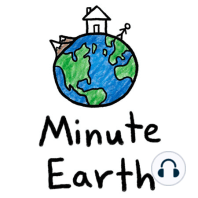2 min listen
How Humans Made Malaria So Deadly
FromMinuteEarth
ratings:
Length:
3 minutes
Released:
Nov 29, 2016
Format:
Podcast episode
Description
Thanks to http://www.givewell.org/ for sponsoring this video! To learn more about the Against Malaria Foundation, visit: http://www.givewell.org/AMF or https://www.againstmalaria.com. Thanks also to our supporters on https://www.patreon.com/MinuteEarth ___________________________________________ FYI: We try to leave jargon out of our videos, but if you want to learn more about this topic, here are some keywords to get your googling started: Malaria - a life-threatening disease caused by parasites that are transmitted to people through the bites of infected female Anopheles mosquitoes. Parasite - an organism that benefits by living in/on a host organism and deriving nutrients at the host's expense. Host - an organism in/on which another organism lives. Protozoa - a group of single-celled microscopic animals (not bacteria or viruses) that includes the Plasmodium species. Plasmodium - a genus of parasitic protozoa, many of which cause malaria in their hosts. Four species regularly infect humans: P. falciparum, P. vivax, P. malariae, & P. ovale. P. falciparum - the Plasmodium species that kills the most people, by causing malignant malaria, the most dangerous form of malaria. Anopheles gambiae - a ‘complex' of at least seven species of mosquitoes that are the main vectors of P. falciparum in sub-Saharan Africa. Species complex - a group of closely related species that look so similar that the boundaries between them are often unclear. Hunting and gathering - depending primarily on wild foods for subsistence Paleontology - the study of fossils and what fossils tell us about the past, about evolution, and about how humans fit into the world. ___________________________________________ Credits (and Twitter handles): Script Writer: Alex Reich (@alexhreich) Script Editor: Emily Elert (@eelert) Video Illustrator: Qingyang Chen Video Director: Emily Elert (@eelert) Video Narrator: Kate Yoshida (@KateYoshida) With Contributions From: Henry Reich, Ever Salazar, Peter Reich, David Goldenberg Music by: Nathaniel Schroeder: http://www.soundcloud.com/drschroeder _________________________________________ Like our videos? Subscribe to MinuteEarth on YouTube: http://goo.gl/EpIDGd Support us on Patreon: https://goo.gl/ZVgLQZ Also, say hello on: Facebook: http://goo.gl/FpAvo6 Twitter: http://goo.gl/Y1aWVC And find us on itunes: https://goo.gl/sfwS6n ___________________________________________ If you liked this week’s video, we think you might also like: Amazing animation of seasonal temperature suitability for malaria https://goo.gl/63pYGt Americapox CGPGrey video https://www.youtube.com/watch?v=JEYh5WACqEk The History of Malaria, an Ancient Disease http://www.cdc.gov/malaria/about/history/ ___________________________________________ References: Carter, R., & Mendis, K. N. (2002). Evolutionary and historical aspects of the burden of malaria. Clinical microbiology reviews, 15(4), 564-594. http://cmr.asm.org/content/15/4/564.full Gething, P. W., et al. (2011). A new world malaria map: Plasmodium falciparum endemicity in 2010. Malaria journal, 10(1), 1. http://malariajournal.biomedcentral.com/articles/10.1186/1475-2875-10-378 Gething, P. W., et al. (2011). Modelling the global constraints of temperature on transmission of Plasmodium falciparum and P. vivax. Parasites & Vectors, 4(1), 1. http://parasitesandvectors.biomedcentral.com/articles/10.1186/1756-3305-4-92 Hay, S. I., et al. (2004). The global distribution and population at risk of malaria: past, present, and future. The Lancet infectious diseases, 4(6), 327-336. https://www.ncbi.nlm.nih.gov/pmc/articles/PMC3145123/ Institute for Health Metrics and Evaluation (IHME). (2016). GBD Compare Data Visualization. Seattle, WA: IHME, University of Washington. Retrieved from http://vizhub.healthdata.org/gbd-compare. Liu, W., et al. (2010). Origin of the human malaria parasite Plasmodium falciparum in gorillas. Nature, 467(7314), 420-425. doi: 10.1038/nature09442 Malaria: Fact sheet (April 2016). Retri
Released:
Nov 29, 2016
Format:
Podcast episode
Titles in the series (100)
Bedbugs. Seriously!?: Don't let the bed bugs bite, no,seriously! by MinuteEarth
